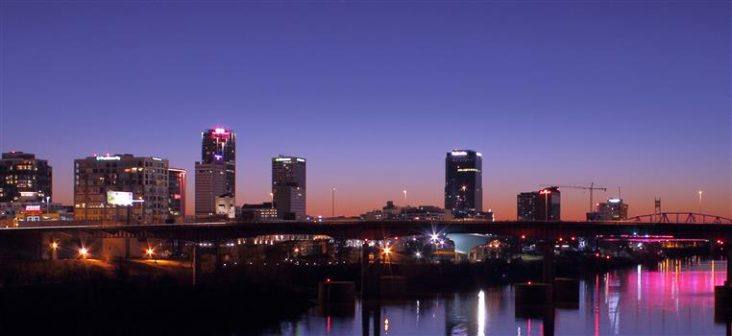Little Rock to submit Amazon HQ2 bid despite potential shortcomings
by September 12, 2017 4:39 pm 995 views

Although Little Rock falls short of some key bidding requirements for Amazon Corp.’s so-called “HQ2,” project, Mayor Mark Stodola said Tuesday (Sept. 12) he still plans to throw the city’s hat in the ring.
Oct. 19 is the deadline to submit proposals for the tech giant’s $5 billion “second headquarters” to house 50,000 employees.
One day after posting on Facebook that Little Rock will submit a bid for Amazon’s HQ2 project, Stodola said Tuesday that Arkansas’ largest city “fits the bill” for the massive super project that is drawing interest from hundreds of U.S. municipalities. In his pitch, Stodola makes the case that Little Rock’s central location and fast-growing knowledge-based talent pool makes the state’s largest metropolitan area (MSA) a strong match for the tech giant’s sizable employee needs.
“Our local and regional talent in software and related fields is strong and getting stronger. Amazon is particularly interested in entrepreneurs who are seizing the opportunity of the digital economy,” Stodola said in a statement, citing the city’s growing tech-oriented downtown hub. “The city has shown leadership in other areas Amazon values including sustainability and a push for ‘smart cities.’”
Mayor Stodola was not available on Tuesday to answer questions about the city’s proposed submission. In his Facebook post on Monday from Shunyi, China, Stodola said the city’s economic development team would work on a proposal with the Little Rock Chamber of Commerce and Arkansas Economic Development Commission (AEDC).
“It will be a challenge, but I am putting together a team that will get together next week and we will have more details then,” Stodola said. “What I can tell you is that we are going to ‘Think Big and Be Creative’ and not hold back when making our pitch – leveraging our many natural assets in going after what would be a transformational project for Little Rock and Arkansas.”
According to Amazon’s RFP, the Silicon Valley corporate giant has a preference for urban areas with more than one million people, a stable and business-friendly environment; urban or suburban locations with the potential to attract and retain strong technical talent, and communities that “think big and creatively” when considering locations and real estate options.
The most recent Census Bureau estimates from 2016 shows the Little Rock MSA population at just over 910,000 people.
Other core requirements for Amazon’s “ideal site” include at least 30 buildings with more than 500,000 square feet of office space through 2019, and an additional 8 million square feet of office space through 2027. The H2Q offices must also be located near an international airport and have direct access to mass transit. The Little Rock airport is not an international airport.
Amazon said it plans to make a total investment of $5 billion over the first 15 to 17 years of project, increasing spending in three different phases until the publicly-traded tech giant has acquired up to 8 million square feet of office space to house its corporate campus and surrounding infrastructure. Amazon said the 50,000 new full-time employees it plans to hire will have an average compensation exceeding $100,000 a year.
Amazon’s urban campus in Seattle employs more than 40,000 people and has been a catalyst for development in downtown Seattle with an abundance of restaurants, services, coffee shops, and redevelopment of South Lake Union and Denny Triangle with its sustainable buildings and open spaces.
Amazon announced its much-publicized RFP a week ago as the West Coast e-commerce giant seeks to expand its logistics and delivery systems following its recent $13.7 billion acquisition of Whole Foods Market. Amazon is the fastest e-commerce company in U.S. history to reach $100 billion in net sales, topping out at nearly $136 billion in 2016 at an annual growth of 28% in the past decade.
According to Brookings Institute research analyst Richard Shearer, Amazon’s RFP narrows the list of viable candidates down to 10 or 12 of the nation’s largest metropolitan areas that can handle the huge influx of 50,000 white collar professionals and their families over the course of the next two decades.
“Amazon’s RFP already winnows the list of potential contenders to only a couple dozen metro areas, at most. In addition to what’s in the RFP, it is probably safe to assume there are other factors the company has already considered, which would shorten its list to only a few places,” Shearer wrote in Sept. 8 post on Brooking Institute’s website called Amazon’s Red Herring.
Shearer also wrote that he expects Amazon’s newest headquarters to be located on the East Coast, giving the company a major corporate presence on both coasts. He said the company may have already made a choice about the location of its second headquarters, opting “to create the illusion of a competition.”
“It is hard to fault Amazon for that. It is a highly competitive, publicly traded company with a fiduciary responsibility to get the best deal for its shareholders. Amazon’s faux competition will lure one otherwise enviable place into handing over a huge amount of its taxpayers’ money to a fabulously wealthy corporation for something that place could have gotten for free.”
Shearer, a senior research associate of Metropolitan Policy Program at the Washington, D.C.-based think tank, also said the multiple city competition will create more costs for the communities that make bids for its headquarters than Amazon can ever hope to recoup through the tax incentives it ultimately receives.
“It will lure many places into spinning their wheels to propose a deal they never had any real chance of closing,” said the Brookings Institute analyst. “These places will waste valuable staff time, including that of elected officials, organizing themselves and their pitch for naught.”
